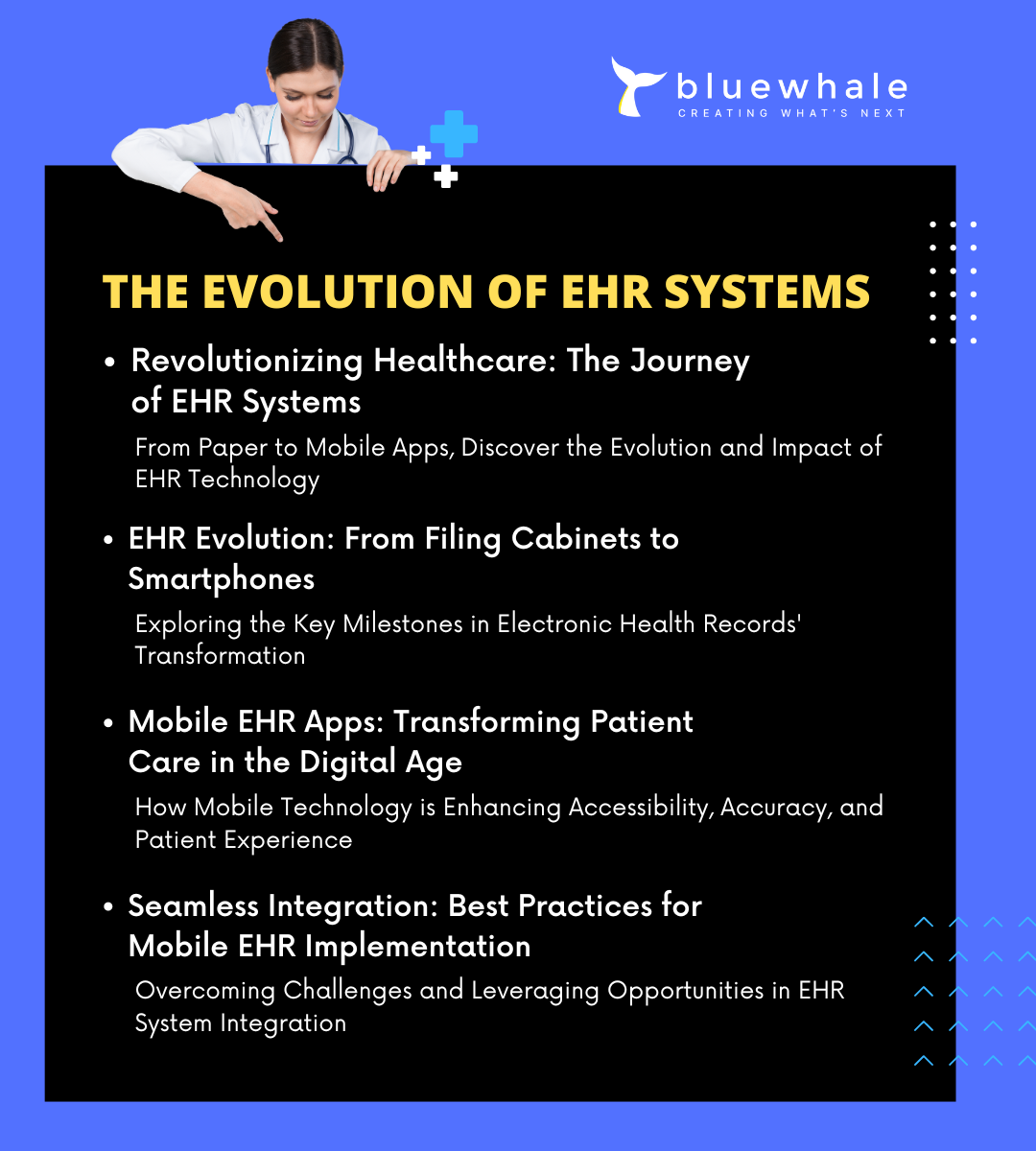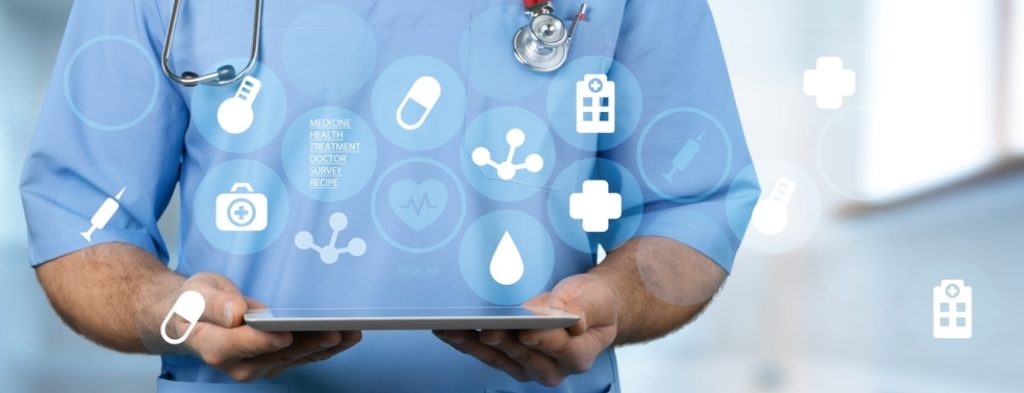Introduction
In the rapidly evolving landscape of healthcare technology, the integration of mobile health apps with EHR (Electronic Health Records) systems has emerged as a critical advancement.
With the surge in demand for accessible healthcare solutions, the convergence of these mobile applications and EHR systems not only enhances the efficiency of healthcare delivery but also significantly improves patient outcomes.
The importance of seamless interoperability, patient portals, e-prescriptions, and electronic health records in facilitating real-time access to patient data cannot be overstated, thereby underscoring the urgency and relevance of this guide.
This article delves deep into the nuances of EHR integration for mobile health apps, starting from the evolution of EHR systems to the anticipated future developments in this domain.
Key areas of focus include the advantages of mobile EHR apps, essential features to prioritize during integration, strategies for navigating the integration workflow, and best practices.
Additionally, it addresses the prevailing integration challenges, showcases exemplary case studies of effective mobile EHR use, and highlights the pivotal role of regulatory compliance. Together, these sections offer a comprehensive roadmap for healthcare providers and app developers aiming to leverage the full potential of Epic EHR and mobile health app integration.
The Evolution of EHR Systems

From Paper to Digital
The transition from paper-based records to electronic health records (EHRs) has been a significant change in the healthcare industry. Initially, medical records were kept on paper and managed through manual filing systems.
By the 1960s, pioneering institutions like the Mayo Clinic began experimenting with electronic methods to manage health records . This shift was driven by the need for more efficient, accessible, and secure management of patient information.
As technology advanced, the 1970s and 1980s saw more substantial efforts from both the private sector and government agencies to develop and implement EHR systems. The Department of Veteran Affairs, for example, was an early adopter with its Decentralized Hospital Computer Program, which later evolved into the comprehensive VistA system . By 2004, the national push towards EHR adoption was solidified with the establishment of the Office of the National Coordinator for Health Information Technology under the U.S. Department of Health and Human Services .
Milestones in EHR Development
The development of EHR systems has been marked by several key milestones that have significantly influenced their adoption and effectiveness:
- Early EHRs: Developed at academic medical centers, these systems used a hybrid of computerized and paper data.
- User-Friendly Interfaces: Introduction of mouse-driven navigation and graphical user interfaces made EHR systems more accessible.
- Federal Incentives: Programs like Meaningful Use financially rewarded healthcare providers for effective EHR use.
- Interoperability Challenges: Despite advancements, issues like data entry complexity and security concerns persist.
The evolution of EHR systems continues as technology progresses, with ongoing improvements aimed at enhancing user experience, security, and interoperability. This ongoing development ensures that EHRs remain pivotal in the transformation of healthcare delivery, supporting a more integrated, efficient, and patient-centered healthcare system.
Advantages of Mobile EHR Apps
Convenience and Accessibility
Mobile EHR apps significantly enhance the convenience and accessibility of patient data for healthcare providers. These apps enable access to critical patient information from virtually anywhere, whether through hospital computers, personal laptops, or mobile devices . This flexibility is crucial for medical professionals who need to make informed decisions quickly and outside of traditional office settings.
Furthermore, the ability to access EHRs from mobile devices reduces the time physicians spend logged into workstations, thereby improving the efficiency of inpatient medical care and facilitating earlier order entry .
Improved Data Accuracy
The implementation of mobile EHR apps has been instrumental in improving the accuracy of medical data entry. By allowing healthcare providers to document patient encounters in real-time, these apps minimize the likelihood of omitting important details that can affect patient care and insurance processes .
Additionally, mobile EHRs ensure that patient data is updated in real-time, which is vital in critical situations where multiple specialists may be involved in patient care . This immediate updating of records ensures that all medical personnel have access to the most current information, enhancing the overall treatment process.
Enhanced Patient Experiences
Mobile EHR apps also play a significant role in enhancing patient experiences by facilitating better communication and engagement. These apps allow patients to receive timely updates about their health, such as lab results or reminders for upcoming tests, through automated alerts and push notifications.
Moreover, a HIPAA compliant mobile EHR app enables secure communication between patients and healthcare providers, ensuring that sensitive health information is shared safely and efficiently. This not only helps in building trust between patients and providers but also supports better decision-making by ensuring all parties are well-informed.
Integrate EHR with your app with Blue Whale Apps!
Features to Prioritize in Mobile EHR Integration
Seamless UI/UX Design
A critical feature to prioritize in mobile EHR integration is the seamless user interface (UI) and user experience (UX) design. Healthcare providers require systems that are intuitive and easy to navigate to minimize the learning curve and enhance user satisfaction.
The implementation of standardized protocols and APIs supports the creation of interfaces that are not only user-friendly but also maintain data integrity and patient privacy .
Interoperability Standards
Interoperability remains a cornerstone of effective mobile EHR integration. Systems must be able to exchange, interpret, and use data seamlessly across various healthcare platforms. This involves adhering to interoperability standards such as the Fast Healthcare Interoperability Resources (FHIR) protocol, which facilitates the connection between diverse healthcare systems ensuring efficient cross-EHR communication.
Additionally, compliance with the United States Core Data for Interoperability (USCDI) standard is crucial for interoperable EHI exchange, which is mandated for new API certification criteria .
Patient Portals and Engagement Tools
Enhancing patient engagement is essential for modern healthcare delivery, and mobile EHR apps play a significant role in this area. Patient portals provide secure, online access to health information, enabling better patient-provider communication and efficient management of healthcare processes like appointment scheduling and prescription refills.
These portals not only support improved patient outcomes through increased engagement but also contribute to the overall efficiency of healthcare services. Moreover, the integration of patient portals in mobile EHR systems should focus on providing real-time updates to patients and ensuring that health records are easily accessible, which can significantly enhance the patient care experience .
Integration Workflow and Best Practices
Planning and Requirements Gathering
Before initiating the integration of Electronic Health Records (EHR) into mobile health apps, it is crucial to thoroughly analyze existing systems and workflows. Organizations must understand their specific needs and identify the objectives they aim to achieve through integration.
A detailed evaluation of the chosen EHR system’s capabilities and compatibility with the app is essential. Collaborating with experienced software development companies can provide invaluable guidance during this phase, ensuring that all legal and regulatory requirements, such as HIPAA compliance, are met .
API and Middleware Usage
For a secure and efficient integration process, it is recommended that only the necessary integration points are exposed to the middleware or integration layer. This layer should authenticate using a specific internal IP address and a valid key value. To maintain HIPAA compliance and ensure data security, all data transactions—including reads, creations, updates, and deletions—must be logged and recorded.
Additionally, data at rest should be securely encrypted to minimize risks . Using asynchronous communication and intelligent caching can enhance the integration’s performance by allowing systems to send and receive data without waiting for responses, ensuring that only new or updated data is transmitted .
Testing and Feedback Loops
Testing the integration thoroughly is critical to ensure data accuracy, functionality, and security. This includes conducting end-to-end testing, simulating real-world scenarios, and validating the integrity of the data exchanged between the app and the EHR system. After deployment, continuous monitoring of the system’s performance is necessary to promptly identify and resolve any potential issues. Feedback mechanisms should also be established to allow for the calibration of clinical decisions and to minimize diagnostic errors. Health IT can facilitate effective communication among clinicians, helping to break down practice silos and provide timely, consistent, and clear feedback .
Addressing Integration Challenges
Data Migration Issues
Migrating data from legacy systems to new Electronic Health Records (EHR) systems presents significant challenges, often likened to fitting a square peg into a round hole. Without appropriate tools and a deep understanding of both the old and new system structures, data migration can lead to critical errors. These errors might include missing or improperly mapped patient information, which can jeopardize patient care and the integrity of medical reporting. The process demands meticulous attention to detail to ensure that data is accurately mapped and that healthcare providers can rely on the new system from the go-live date .
System Downtime
Downtime events pose a substantial risk to patient safety due to the unavailability of critical EHR functionalities like clinical documentation and medication management. These events often result in delayed or suboptimal care. Institutions that have long used EHRs may find their staff ill-prepared for paper-based care processes during downtimes, increasing stress and the likelihood of errors . Despite the risks, many healthcare organizations lack comprehensive downtime contingency plans. Effective planning should include regular downtime drills to test staff readiness and ensure that procedures for both downtime and recovery are well understood and practiced .
User Training and Adaptation
The successful adoption of EHR systems heavily relies on adequate training and the adaptation of users to the new technology. Resistance to moving from paper-based to electronic systems is common, but with effective training strategies, this can be overcome. Training should be ongoing and include practical exercises that help staff understand essential functions and workflows of the EHR system. Superusers, or staff with extensive training, play a crucial role in facilitating smooth transitions by supporting their peers and promoting the use of the system through their expertise .
Implementing an EHR system is not just about technology but also about people and processes. Addressing these integration challenges through meticulous planning, comprehensive training, and robust contingency measures is essential for minimizing risks and enhancing the effectiveness of healthcare delivery through advanced EHR systems.
Case Examples of Effective Mobile EHR Use
Example 1: Telemedicine
Telemedicine has revolutionized the management of chronic diseases by enabling continuous, real-time interaction between patients and healthcare providers. Utilizing mobile health technologies, telemedicine facilitates the remote monitoring and counseling of patients, significantly enhancing the effectiveness of physicians. For instance, wearable monitors and mobile apps allow for the collection of vital signs and health data, which are crucial for managing care plans for patients with chronic conditions . This integration of technology ensures that healthcare is accessible, especially for patients in remote or underserved areas, providing them with the necessary tools to manage their health effectively.
Example 2: Remote Patient Monitoring
Remote Patient Monitoring (RPM) represents a critical component in chronic disease management, leveraging patient-generated health data to enhance clinical decision-making and patient engagement. The market for RPM devices, which include blood pressure monitors, glucose monitors, and wearable technology like fitness trackers, is expected to grow significantly, reaching USD 4.07 billion by 2030 . These devices play a pivotal role in monitoring vital health metrics and transmitting this data back to healthcare providers, ensuring that patients receive timely and appropriate interventions.
Example 3: Chronic Disease Management
Chronic Disease Management (CDM) programs are increasingly incorporating health IT to optimize the care of patients with chronic conditions like diabetes, hypertension, and heart disease. These programs utilize a variety of health IT applications such as clinical decision support systems, health information exchanges, and patient-centered applications like patient portals and personal health records . These tools not only support the healthcare providers in managing patient information and monitoring health outcomes but also empower patients through educational resources and self-management tools. This comprehensive approach to chronic disease management underscores the effectiveness of integrating mobile EHR systems with robust health IT frameworks.
The Role of Compliance in EHR Integration
Understanding HIPAA
The Health Insurance Portability and Accountability Act (HIPAA) sets the standard for protecting sensitive patient data in the United States. Any entity dealing with protected health information (PHI) must ensure that all the required physical, network, and process security measures are in place and followed. For mobile EHR apps, this includes ensuring that PHI is not used or disclosed improperly. The EHR system developer may be held accountable for HIPAA compliance if they receive patient data from a covered entity .
Ensuring Data Protection
Data protection is a critical component of EHR integration. Mobile EHR apps must support interoperability standards and rules as healthcare requirements evolve. It is essential that these apps work seamlessly across various platforms and technologies to enable health information exchange with labs, radiology providers, public health registries, and more. Compliance with both HIPAA in the U.S. and the General Data Protection Regulation (GDPR) in Europe is crucial. Developers must ensure that their software supports these standards, and they should conduct a HIPAA risk assessment to prevent potential violations .
Compliance Checklists
Creating a compliance checklist is an effective way to ensure that all necessary safeguards are in place to protect patient data. This checklist should include steps such as:
- Access Control: Implement strict controls on who can view or modify confidential information. This is crucial in preventing unauthorized access to PHI .
- Secure Authentication: Verify the identity of users accessing the system. This can include methods like biometrics, passwords, physical tokens, or PINs .
- Transmission Security: Ensure that data transmitted over the network is encrypted, using protocols like HTTPS to secure PHI during transmission .
- Data Disposal: Properly dispose of PHI when it is no longer needed, ensuring that it is completely destroyed and that there are no remnants in any backups .
- Data Backup and Storage: Regularly back up data and store it securely, preferably in a different location to maximize data security .
- Audit Controls: Monitor and record all activity related to PHI within the system to identify and address potential security violations promptly .
- Encryption: Use strong encryption methods to protect data from unauthorized access, both at rest and in transit .
Adhering to these steps not only ensures compliance with HIPAA but also builds trust with users by safeguarding their personal health information.
Case Studies: Successful Mobile EHR Integrations
Mayo Clinic’s Mobile EHR Implementation
Mayo Clinic’s implementation of a mobile Electronic Health Record (EHR) system serves as a benchmark in the healthcare industry. With a focus on improving patient outcomes and operational efficiency, Mayo Clinic adopted an advanced mobile EHR platform that integrates seamlessly with their existing systems. This integration has enabled healthcare providers to access patient records on-the-go, leading to faster decision-making and more personalized patient care. The use of mobile EHRs at Mayo Clinic has also facilitated better coordination among medical staff, enhancing the overall quality of care delivered to patients.
Kaiser Permanente’s EHR-Enhanced Patient Engagement
Kaiser Permanente has successfully leveraged mobile EHR integration to boost patient engagement. By incorporating patient portals and engagement tools within their mobile EHR system, Kaiser Permanente has empowered patients to take an active role in their healthcare journey. Patients can easily access their medical records, schedule appointments, and communicate with their healthcare providers through secure messaging features. This approach has not only improved patient satisfaction but also increased adherence to treatment plans and follow-up appointments, ultimately leading to better health outcomes.
Cedars-Sinai’s EHR for Telehealth Services
Cedars-Sinai has harnessed the power of mobile EHR integration to enhance their telehealth services. With the integration of EHR systems into their telehealth platform, Cedars-Sinai healthcare providers can access comprehensive patient information during virtual consultations. This capability has been particularly valuable during the COVID-19 pandemic, allowing patients to receive high-quality care without the need for in-person visits. The integration has also streamlined administrative processes, reducing the burden on staff and improving the efficiency of telehealth services.
These case studies highlight the transformative impact of mobile EHR integration in healthcare settings. By prioritizing user-friendly interfaces, interoperability standards, and patient engagement tools, organizations like Mayo Clinic, Kaiser Permanente, and Cedars-Sinai have set the stage for the future of healthcare delivery. The successful implementation of mobile EHR systems not only improves the quality of care but also enhances operational efficiency, paving the way for a more connected and patient-centric healthcare ecosystem.
Future Developments in Mobile EHR Integration
Growth of AI in EHR
The integration of Artificial Intelligence (AI) into Electronic Health Records (EHR) is poised for significant growth, with the global AI healthcare market expected to expand from $22.45 billion in 2023 to a staggering $208.2 billion by 2030 . This surge is largely attributed to AI’s ability to enhance clinical decision support within EHR systems. Hospitals that have adopted AI-driven EHR systems have seen a 30% reduction in preventable hospitalizations , underscoring the profound impact of AI on healthcare delivery. Furthermore, AI technologies, including predictive analytics and machine learning, are revolutionizing EHR by providing healthcare providers with tools to forecast patient needs and streamline treatment plans .
Enhanced Patient Interactions
Mobile EHR integration enhances real-time patient engagement significantly. Patients are increasingly using mobile applications linked with EHR systems to input data, fostering a dynamic relationship with healthcare providers . This integration has led to a 15% improvement in medication adherence, showcasing the practical benefits of mobile EHR apps in everyday healthcare management . Additionally, the use of AI in these systems not only supports more accurate and timely health data analysis but also improves the overall patient experience by facilitating personalized treatment recommendations .
Global Trends and Innovations
The future of mobile EHR integration is also marked by an increasing adoption of standards like Fast Healthcare Interoperability Resources (FHIR), which ensure that EHR systems can seamlessly communicate with other healthcare applications and devices . This standardization is crucial for maintaining the integrity and security of health data across different platforms. Moreover, the global EMR market itself is anticipated to reach $42.4 billion by 2027, driven by the ongoing demand for improved healthcare workflows and patient outcomes . As part of this trend, technologies such as blockchain are emerging as key players, offering a secure and transparent framework for managing health data and minimizing risks associated with data breaches and unauthorized access .
Wearable Device Integration
The integration of wearable devices with mobile EHR systems is another emerging trend that holds great promise for the future of healthcare. Wearable devices, such as smartwatches and fitness trackers, can continuously monitor a patient’s vital signs and activity levels. By integrating this data with mobile EHRs, healthcare providers can gain real-time insights into a patient’s health status, enabling proactive and personalized care. This seamless flow of information between wearable devices and EHR systems has the potential to improve chronic disease management, enhance patient engagement, and promote overall wellness.
Blockchain Technology for Data Integrity
Blockchain technology is set to play a significant role in ensuring data integrity and transparency in mobile EHR systems. By providing a decentralized and immutable ledger, blockchain can enhance the security and accuracy of patient records. Each transaction or update to the EHR is recorded as a block, which is then linked to the previous block, creating a chain of secure and verifiable data. This technology can prevent unauthorized access, reduce the risk of data tampering, and streamline the sharing of patient information across healthcare providers.
The future of mobile EHR integration is marked by exciting advancements that will reshape the healthcare landscape. The incorporation of AI and predictive analytics, enhanced data security measures, wearable device integration, and blockchain technology will drive innovation and improve the quality of patient care. By staying abreast of these trends, healthcare providers and app developers can leverage the full potential of mobile EHR systems to create a more connected, efficient, and patient-centric healthcare ecosystem.
[Read More: Discover the Top 10 Healthcare App Development Trends to Watch in 2024]
Conclusion
The integration of Electronic Health Records (EHR) with mobile health apps represents a significant advancement in the healthcare industry. This comprehensive guide has explored the evolution of EHR systems, the advantages of mobile EHR apps, essential features to prioritize, and best practices for successful integration. Additionally, it has addressed the challenges associated with EHR integration and highlighted exemplary case studies of organizations that have effectively implemented mobile EHR systems.
Looking ahead, the future of mobile EHR integration is promising, with emerging trends such as Artificial Intelligence, enhanced data security measures, wearable device integration, and blockchain technology set to revolutionize healthcare delivery. By embracing these advancements, healthcare providers and app developers can create a more connected, efficient, and patient-centric healthcare ecosystem.
For organizations looking to integrate EHR with their mobile health apps, partnering with experienced software development companies can provide invaluable guidance and support. Blue Whale Apps, with its expertise in EHR integration, is well-positioned to help healthcare providers navigate this complex process and achieve seamless interoperability.
By leveraging the full potential of mobile EHR systems, healthcare providers can improve patient outcomes, enhance operational efficiency, and deliver a higher quality of care. The future of healthcare is mobile, and the integration of EHR with mobile health apps is a critical step towards realizing this vision.










